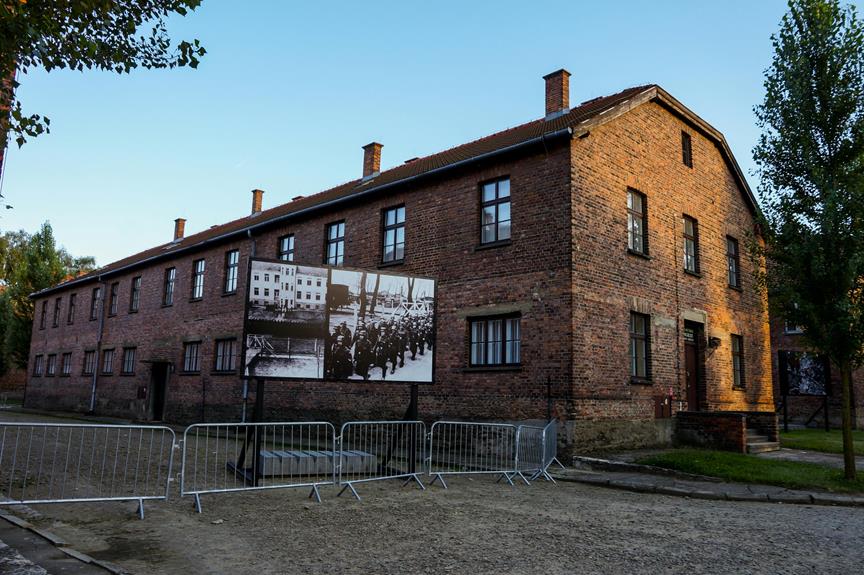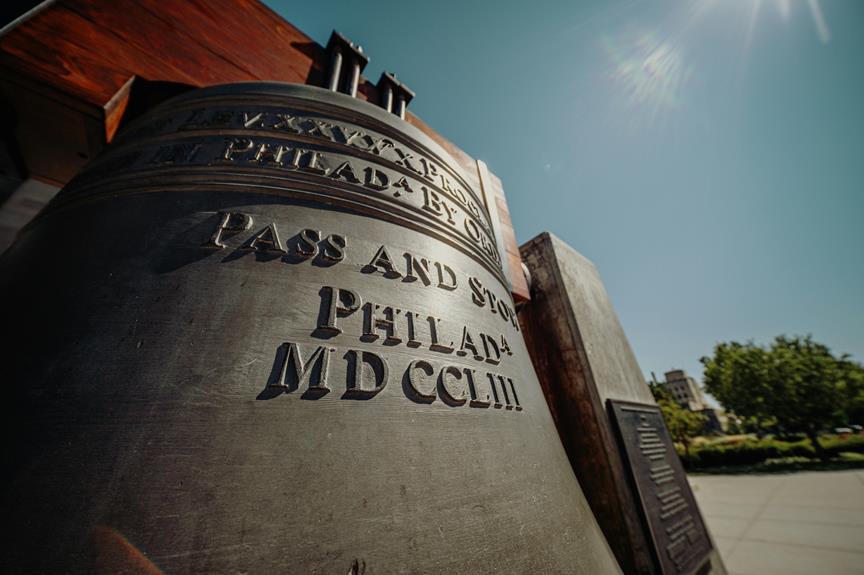The Museum of the Second World War in Gdansk, Poland, offers a unique perspective on the tumultuous period of global conflict that shaped the course of history. With its carefully curated exhibitions and innovative approach to storytelling, this institution provides a platform for reflection and understanding of the complexities surrounding World War II. Exploring the museum's extensive collection and thematic displays reveals a nuanced narrative that invites visitors to contemplate the human experiences, political landscapes, and lasting impacts of this pivotal era.
Key Takeaways
- Located in Gdansk, Poland, the museum educates on WWII.
- Offers immersive exhibits, artifacts, and interactive technology.
- Promotes critical thinking and reflection on historical events.
- Provides educational resources, workshops, and guided tours.
- Impactful legacy of cultural remembrance and global awareness.
Museum Location and Hours
Situated in the heart of Gdansk, Poland, the Museum of the Second World War welcomes visitors daily with its diverse exhibits and informative displays. The museum's central location makes it easily accessible to both tourists and locals, offering a profound educational experience for all who enter its doors. Open seven days a week, the Museum of the Second World War operates from 10:00 am to 6:00 pm, allowing ample time for visitors to explore the extensive collection at their own pace.
Located within walking distance of the city's main attractions, the museum's accessibility enhances the overall visitor experience. Whether arriving by public transportation or car, the museum's convenient location simplifies travel logistics, enabling individuals to immerse themselves in the history and stories of World War II without difficulty. Upon entering, visitors are greeted by knowledgeable staff members ready to assist and guide them through the various exhibits, enhancing the overall educational journey.
The museum's operating hours cater to a wide range of schedules, accommodating both morning and afternoon visits. This flexibility ensures that visitors can allocate sufficient time to investigate the intricate details of the Second World War, fostering a deeper understanding of the global conflict and its lasting impact on society. Overall, the Museum of the Second World War in Gdansk stands as a beacon of historical enlightenment, inviting individuals from all walks of life to explore and reflect on the lessons of the past.
Historical Significance and Mission
The Museum of the Second World War in Gdansk, Poland, holds profound historical significance and is driven by a mission to educate and commemorate the events and impact of the global conflict. Established in 2017, the museum stands as a proof to the experiences of individuals and nations during World War II. Its goal is to guarantee that the lessons learned from this devastating period in history are not forgotten but serve as a guiding light for future generations.
The relevance of the Museum of the Second World War lies in its ability to provide visitors with a detailed understanding of the war's complexities, including its causes, consequences, and the human stories that emerged from it. By showcasing a wide array of artifacts, documents, and multimedia exhibits, the museum offers a nuanced perspective on the war, emphasizing the importance of remembrance, reconciliation, and peace.
Through its mission-driven approach, the museum actively engages with the public to foster dialogue, critical thinking, and reflection on the past. By promoting historical literacy and awareness, the Museum of the Second World War plays an essential role in shaping collective memory and preserving the legacy of those who lived through this tumultuous period. It serves as a living proof to the resilience of humanity in the face of adversity and the enduring quest for freedom and peace.
Main Exhibition Areas
Exploring the Main Exhibition Areas at the Museum of the Second World War in Gdansk, Poland, provides visitors with a thorough journey through the multifaceted aspects of the global conflict. The museum's main exhibition areas are meticulously designed to offer a detailed understanding of the events that transpired during this significant period in history.
One of the key features of the main exhibition areas is the use of timeline displays. These displays guide visitors through the chronological progression of the Second World War, highlighting major milestones, battles, and developments that shaped the outcome of the conflict. By following the timeline, visitors can grasp the interconnected nature of events and how they unfolded over time.
In addition to timeline displays, the main exhibition areas also feature immersive dioramas that bring key moments of the war to life. These dioramas recreate scenes from significant battles, key decision-making meetings, and everyday life during the war. By immersing visitors in these detailed reconstructions, the museum offers a more vivid and engaging way to learn about the experiences of those who lived through this tumultuous period.
Interactive Displays and Technology
Utilizing cutting-edge interactive displays and innovative technology, the Museum of the Second World War in Poland enhances visitor engagement and facilitates a deeper understanding of the historical context surrounding the global conflict. The museum offers virtual tours that allow visitors to explore key events and locations of the war through immersive digital experiences. Augmented reality further enriches the visit by overlaying historical images and information onto the physical exhibits, providing a dynamic and interactive learning environment.
In addition to virtual tours, the museum features hands-on activities that bring the history of the Second World War to life. Visitors can engage with multimedia displays that showcase personal accounts, archival footage, and interactive timelines, offering a thorough and interactive educational experience. Through these interactive elements, visitors can gain a more profound appreciation for the complexities and impact of the war on a global scale.
Moreover, the incorporation of innovative technology enhances visitor participation and encourages a deeper connection with the historical narrative. By integrating virtual tours, augmented reality, hands-on activities, and multimedia displays, the Museum of the Second World War in Poland creates a compelling and engaging journey through one of the most significant events in modern history.
Artifact Highlights and Collections
In showcasing a diverse array of artifact highlights and collections, the Museum of the Second World War in Poland offers a tangible link to the past, allowing visitors to engage with physical remnants that embody the historical significance of the era. The artifacts on display have been meticulously curated and preserved using advanced techniques to guarantee their longevity and educational value.
- Artifact Discovery: The museum's collection includes a wide range of artifacts discovered from various battlefields, bunkers, and personal effects of soldiers. These items offer a unique insight into the daily lives and experiences of individuals during the war.
- Preservation Techniques: The museum employs cutting-edge preservation techniques to protect delicate artifacts such as letters, uniforms, and weaponry. Climate-controlled environments, specialized lighting, and careful handling help sustain the integrity of these historical items.
- Interactive Exhibits: Many artifacts are incorporated into interactive exhibits, allowing visitors to not only see but also touch and interact with certain pieces. This hands-on approach enhances the visitor experience and provides a deeper understanding of the wartime period.
- Thematic Collections: The museum organizes artifacts into thematic collections, focusing on specific aspects of the war such as resistance movements, civilian life, and technological advancements. This categorization helps visitors navigate the vast array of artifacts while gaining a thorough understanding of World War II.
Educational Programs and Workshops
The Museum of the Second World War in Poland offers a wide range of educational programs and workshops aimed at fostering a deeper understanding of the historical events surrounding World War II. Through hands-on activities and immersive learning experiences, visitors have the opportunity to engage with history in a tangible and impactful way. These programs cater to individuals of all ages, from school children to adults, making the museum a valuable resource for learning about this significant period in history.
Educational resources at the museum include curated exhibitions, guided tours, and interactive workshops that explore various aspects of World War II. Participants can explore primary sources, artifacts, and multimedia presentations that bring history to life. The museum's outreach initiatives extend beyond its physical location, reaching schools, community groups, and online audiences to guarantee widespread access to educational opportunities.
Workshops offered by the museum cover a diverse range of topics, such as wartime propaganda, resistance movements, and the experiences of civilians during the war. By engaging with these themes in a structured setting, participants gain a nuanced understanding of the complexities of World War II and its lasting impact on society. Overall, the educational programs and workshops provided by the Museum of the Second World War in Poland serve as essential tools for promoting historical literacy and fostering critical thinking skills among visitors.
Visitor Experience and Amenities
Improving the overall visitation experience, the Museum of the Second World War in Poland offers a wide range of amenities for visitors to enjoy. These amenities cater to various needs and preferences, guaranteeing a comfortable and enriching visit for all.
Here are four key visitor services and accessibility options available at the museum:
- Multilingual Guides: Visitors can benefit from informative guided tours available in multiple languages, enhancing the understanding of the exhibits and historical context for international guests.
- Interactive Exhibits: The museum features interactive displays and multimedia presentations that engage visitors of all ages, providing a hands-on learning experience that is both educational and entertaining.
- Accessible Facilities: The museum is equipped with facilities such as ramps, elevators, and designated parking spaces to ensure accessibility for visitors with mobility challenges, making it inclusive for all.
- Visitor Amenities: To enhance the overall visitor experience, the museum offers amenities like rest areas, cafes, and gift shops where guests can relax, grab a refreshment, or purchase souvenirs to commemorate their visit.
These visitor services and accessibility options not only make the Museum of the Second World War in Poland welcoming to a diverse audience but also contribute to creating a memorable and informative experience for all who visit.
Impact and Legacy of the Museum
Exploring the lasting impact and historical legacy of the Museum of the Second World War in Poland reveals its profound significance in commemorating and educating about this pivotal period in global history. The museum's influence extends beyond its physical walls, shaping cultural remembrance and fostering educational impact. By engaging visitors with exhibits that highlight the human stories and historical events of World War II, the museum plays an essential role in preserving the memory of the war and its consequences.
| Impact | Legacy |
|---|---|
| Cultural remembrance | Generational understanding |
| Educational impact | Global awareness |
The museum's emphasis on educational programming ensures that future generations gain a deeper understanding of the complexities of the Second World War. Through interactive exhibits and curated collections, visitors not only learn about the past but also develop a sense of empathy and critical thinking skills essential for maneuvering in today's world. This generational understanding fosters global awareness, encouraging individuals to reflect on the causes and consequences of war and work towards a more peaceful future. In this way, the Museum of the Second World War in Poland stands as a beacon of remembrance and a catalyst for shaping a more informed and compassionate society.
Frequently Asked Questions
Are There Any Special Events or Exhibitions Held at the Museum?
Special events and temporary exhibitions provide enriching experiences for visitors. They offer unique insights, allowing for a deeper understanding of historical events and their impact. These events often showcase rare artifacts, host expert talks, and interactive displays, enhancing the overall museum experience.
Can Visitors Bring Food and Drinks Into the Museum?
Visitors often ponder the dining dilemma when exploring cultural venues. Understanding food regulations and visitor etiquette is important for a seamless museum experience.
While policies may vary, many institutions encourage guests to enjoy snacks or beverages in designated areas. However, it's advisable to verify specific rules beforehand to avoid any culinary conundrums during your visit.
Is There a Gift Shop Where Visitors Can Purchase Souvenirs?
Yes, the museum offers a gift shop where visitors can browse and purchase a variety of souvenirs related to the Second World War.
The gift shop provides an array of merchandise options, including books, replicas, apparel, and other themed items.
Visitors have the freedom to explore and choose from a selection of historically significant memorabilia to commemorate their visit and enhance their understanding of this pivotal period in history.
Are There Guided Tours Available for Visitors?
Group tours and private tours are available for visitors seeking a guided experience at the museum. These tours provide in-depth insights into the exhibits, allowing for a more engaging and informative visit.
Additionally, audio guides are available for those who prefer a self-guided experience, enhancing the exploration of the interactive exhibits. Whether visitors choose a guided tour or opt for audio guides, both options cater to varying preferences and levels of engagement.
Is Photography Allowed Inside the Museum?
Photography guidelines and etiquette play a vital role in historical preservation.
While many museums allow photography for personal use, restrictions may apply to safeguard artifacts' integrity and significance.
For instance, the Louvre in Paris permits non-flash photography to guarantee artworks' preservation.
Implementing such guidelines ensures that visitors can capture memories while respecting the historical value of the objects on display.
Conclusion
To sum up, the Museum of the Second World War in Gdansk, Poland, serves as an essential educational institution preserving the legacy of the global conflict.
With over 2 million visitors since its establishment in 2017, the museum continues to engage audiences of all ages through its immersive exhibitions and interactive displays.
This cultural landmark stands as a confirmation to the importance of remembering and understanding the impact of World War II on the world today.


